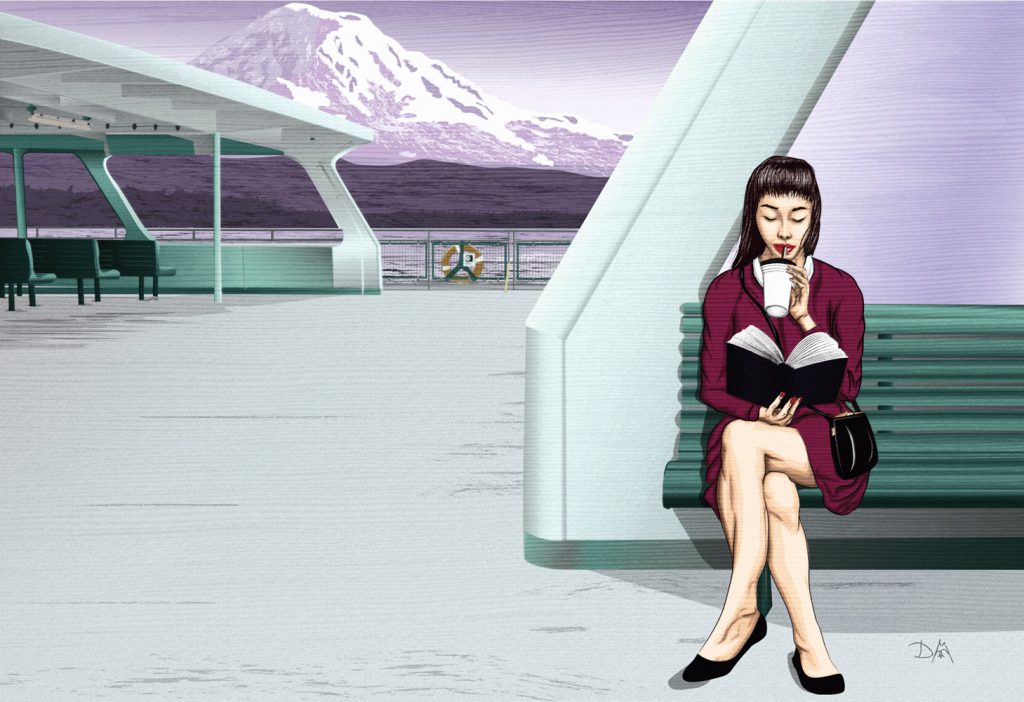
This is probably a good place to explain something of my “process” as well as inspiration for artwork. The above image is called Ugetsu. If it looks vaguely “Japanese” it’s because it’s supposed to, because the title is borrowed from Ugetsu Monogatari, but there are some other influences working here.
When I was a boy, my mother was going to school for her teaching credential and my father would often drive us up to a small Japanese restaurant out in Carmichael where we lived. I remember it being called Tokyo Sukiyaki. You have to remember that back then, sukiyaki was pretty much the only dish most Americans actually knew about from Japan, unless they had either been there as tourists, business people or serving in the military. The memory of those visits to Tokyo Sukiyaki is perhaps best related somewhere else (Ada has already stolen it), but aside from saba and the staff, I remember the woodcuts most of all.
Yes, of course they had The Great Wave at Kanagawa there. It was sort of a code requirement at the time. But there were many others, and years later, when I was old enough to start appreciating artwork on my own, I found a way back into Japanese woodcut artwork.
Oddly enough it began when a friend of mine visited with her four-year-old daughter and I was finally introduced to the world of Studio Ghibli, but rather than dive deeper into Anime, I started looking for and at the woodcut artwork that formed a foundation for the magnificent backgrounds Studio Ghibli is famous for. I had an old Taschen book of Hiroshige I had picked up somewhere, and fortunately, there was a Kinokuniya in Seattle, so I was able to find more books, and yes, the Kawase Hasui calendars.

Kawase Hasui is perhaps the most famous of the later “shin-hanga” practitioners of woodcut art. Basically, the heyday of Japanese Woodcut is traditionally held to be the “golden period” during the latter part of the Tokugawa Shogunate, exemplified by Hokusai, Hiroshige and Utamaro amongst others. During the Meiji Restoration, the art form began to be ‘lost’ as Western art production techniques became popular. But eventually the form came back in the “shin-hanga” or “new prints.”
This style of artwork greatly influenced me not only in terms of subject matter, but also technically. Images such as Rainier Crossing #1 combine a multilayered approach. Each layer is drawn in Illustrator and then blended (with wood grain images) in Photoshop.

Composition traditions are also something you’ll see. Most landscapes do not have central figures. As I had mentioned earlier in my post about Caspar David Friedrich, the Rückfigur makes frequent appearances. This new image of Ada contemplating a desert sunset (and by extension her existence) is just such an image. In this case, the wood grain layers really added to the texture of the entire piece. I never really know how it will turn out when I start, but I know when it’s “finished.”
Links:
How to Order my work
Since these are digital images, there is no “original,” but it’s very easy to manipulate and resize them. They look best printed on metal, but go ahead and ping me and we can work something else out.
Hiroshi Yoshida on woodblock printing:
http://woodblock.com/encyclopedia/entries/011_07/011_07.html
The Art of Japan: Selections of Shin Hanga Prints (if you can afford that sort of thing)
https://www.theartofjapan.com/art/shin-hanga/
Artelino: more on Shin Hanga
https://www.artelino.com/articles/shin_hanga.asp
Ugetsu Monogatari “Tales of Moonlight and Rain” by Akinari Ueda
Columbia University Press Edition | Indiebound
